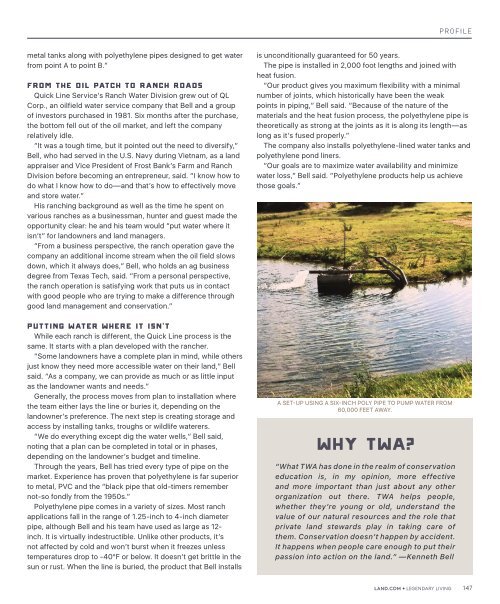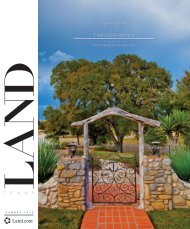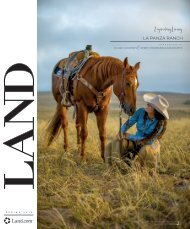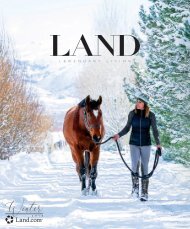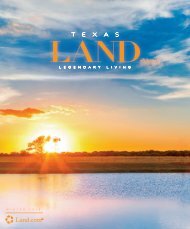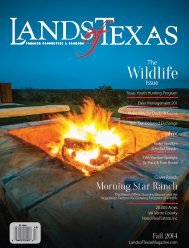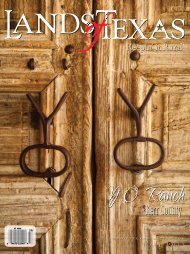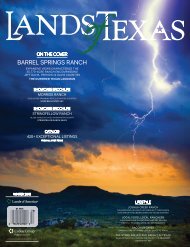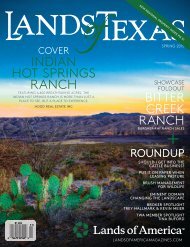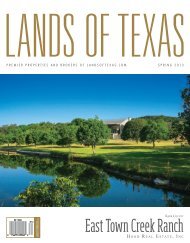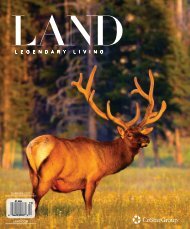You also want an ePaper? Increase the reach of your titles
YUMPU automatically turns print PDFs into web optimized ePapers that Google loves.
PROFILE<br />
metal tanks along with polyethylene pipes designed to get water<br />
from point A to point B.”<br />
FROM THE OIL PATCH TO RANCH ROADS<br />
Quick Line Service’s Ranch Water Division grew out of QL<br />
Corp., an oilfield water service company that Bell and a group<br />
of investors purchased in 1981. Six months after the purchase,<br />
the bottom fell out of the oil market, and left the company<br />
relatively idle.<br />
“It was a tough time, but it pointed out the need to diversify,”<br />
Bell, who had served in the U.S. Navy during Vietnam, as a land<br />
appraiser and Vice President of Frost Bank’s Farm and Ranch<br />
Division before becoming an entrepreneur, said. “I know how to<br />
do what I know how to do—and that’s how to effectively move<br />
and store water.”<br />
His ranching background as well as the time he spent on<br />
various ranches as a businessman, hunter and guest made the<br />
opportunity clear: he and his team would “put water where it<br />
isn’t” for landowners and land managers.<br />
“From a business perspective, the ranch operation gave the<br />
company an additional income stream when the oil field slows<br />
down, which it always does,” Bell, who holds an ag business<br />
degree from <strong>Texas</strong> Tech, said. “From a personal perspective,<br />
the ranch operation is satisfying work that puts us in contact<br />
with good people who are trying to make a difference through<br />
good land management and conservation.”<br />
PUTTING WATER WHERE IT ISN’T<br />
While each ranch is different, the Quick Line process is the<br />
same. It starts with a plan developed with the rancher.<br />
“Some landowners have a complete plan in mind, while others<br />
just know they need more accessible water on their land,” Bell<br />
said. “As a company, we can provide as much or as little input<br />
as the landowner wants and needs.”<br />
Generally, the process moves from plan to installation where<br />
the team either lays the line or buries it, depending on the<br />
landowner’s preference. The next step is creating storage and<br />
access by installing tanks, troughs or wildlife waterers.<br />
“We do everything except dig the water wells,” Bell said,<br />
noting that a plan can be completed in total or in phases,<br />
depending on the landowner’s budget and timeline.<br />
Through the years, Bell has tried every type of pipe on the<br />
market. Experience has proven that polyethylene is far superior<br />
to metal, PVC and the “black pipe that old-timers remember<br />
not-so fondly from the 1950s.”<br />
Polyethylene pipe comes in a variety of sizes. Most ranch<br />
applications fall in the range of 1.25-inch to 4-inch diameter<br />
pipe, although Bell and his team have used as large as 12-<br />
inch. It is virtually indestructible. Unlike other products, it’s<br />
not affected by cold and won’t burst when it freezes unless<br />
temperatures drop to -40°F or below. It doesn’t get brittle in the<br />
sun or rust. When the line is buried, the product that Bell installs<br />
is unconditionally guaranteed for 50 years.<br />
The pipe is installed in 2,000 foot lengths and joined with<br />
heat fusion.<br />
“Our product gives you maximum flexibility with a minimal<br />
number of joints, which historically have been the weak<br />
points in piping,” Bell said. “Because of the nature of the<br />
materials and the heat fusion process, the polyethylene pipe is<br />
theoretically as strong at the joints as it is along its length—as<br />
long as it’s fused properly.”<br />
The company also installs polyethylene-lined water tanks and<br />
polyethylene pond liners.<br />
“Our goals are to maximize water availability and minimize<br />
water loss,” Bell said. “Polyethylene products help us achieve<br />
those goals.”<br />
A SET-UP USING A SIX-INCH POLY PIPE TO PUMP WATER FROM<br />
60,000 FEET AWAY.<br />
WHY TWA?<br />
“What TWA has done in the realm of conservation<br />
education is, in my opinion, more effective<br />
and more important than just about any other<br />
organization out there. TWA helps people,<br />
whether they’re young or old, understand the<br />
value of our natural resources and the role that<br />
private land stewards play in taking care of<br />
them. Conservation doesn’t happen by accident.<br />
It happens when people care enough to put their<br />
passion into action on the land.” —Kenneth Bell<br />
<strong>LAND</strong>.COM • LEGENDARY LIVING<br />
147


